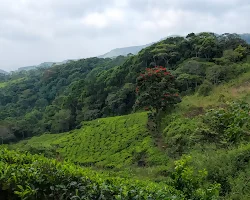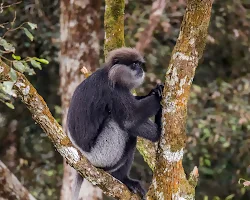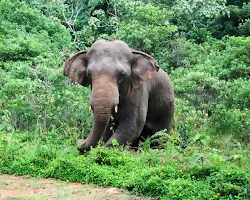Sinharaja Forest Reserve is a renowned tropical rainforest located in the southwest region of Sri Lanka. It is recognized as one of the island nation’s most vital natural treasures due to its exceptional biodiversity and ecological significance. Covering an area of approximately 8,900 hectares, the forest reserve was designated as a UNESCO World Heritage Site in 1988 in recognition of its outstanding universal value. This essay delves into the history, ecological importance, biodiversity, conservation efforts, and challenges faced by the Sinharaja Forest Reserve in approximately 1600 words.
southwest region of Sri Lanka. It is recognized as one of the island nation’s most vital natural treasures due to its exceptional biodiversity and ecological significance. Covering an area of approximately 8,900 hectares, the forest reserve was designated as a UNESCO World Heritage Site in 1988 in recognition of its outstanding universal value. This essay delves into the history, ecological importance, biodiversity, conservation efforts, and challenges faced by the Sinharaja Forest Reserve in approximately 1600 words.
The history of Sinharaja Forest Reserve traces back to ancient times when vast rainforests spanned across Sri Lanka. However, over the centuries, most of these forests were cleared for agriculture, timber, and urbanization, leaving only small fragments of the original forest cover. Sinharaja, which translates to “Lion King,” derives its name from the legend that the last Sri Lankan lion was believed to have roamed in this forest.
In the 19th century, British colonialists recognized the ecological value of Sinharaja and took initial steps to protect the forest from extensive exploitation. It was declared a Crown Reserve in 1875, restricting some destructive activities such as logging and hunting. Later, in 1978, the Sri Lankan government officially designated Sinharaja as a National Wilderness Area. Finally, in 1988, it received UNESCO World Heritage Site status, affirming its global significance and raising international attention to its conservation.
Sinharaja Forest Reserve is a vital ecological hotspot, playing a significant role in maintaining the island’s biodiversity and contributing to the region’s climate regulation. The forest acts as a natural watershed, providing numerous rivers and streams with a steady flow of water throughout the year. It also helps mitigate soil erosion and aids in flood control, benefiting surrounding communities and ecosystems.
The forest’s rich biodiversity is one of its defining features, making it an ecological gem in the region. With its untouched primary rainforest, Sinharaja provides a unique habitat for a wide array of flora and fauna. It is home to many endemic and threatened species found nowhere else in the world, making it a conservation priority for global biodiversity.
ecological gem in the region. With its untouched primary rainforest, Sinharaja provides a unique habitat for a wide array of flora and fauna. It is home to many endemic and threatened species found nowhere else in the world, making it a conservation priority for global biodiversity.
Sinharaja houses an impressive range of plant species, making it a biodiversity treasure trove. It is estimated that the forest contains around 830 plant species, with a majority being endemic. Among the endemic flora, some noteworthy species include the iconic Sri Lankan Blue Magpie (Urocissa ornata), the Sri Lankan Junglefowl (Gallus lafayettii), and the Red-faced Malkoha (Phaenicophaeus pyrrhocephalus).
The canopy layer of the forest showcases massive trees, such as Dipterocarpus sp., Mesua sp., and Shorea sp. The sub-canopy and understory levels support various species of ferns, lianas, and epiphytes, adding to the overall ecological diversity.
The fauna of Sinharaja Forest Reserve is equally captivating, with a remarkable assortment of mammals, birds, reptiles, amphibians, and insects. Several endangered and endemic species call this forest home, making its conservation all the more critical.
assortment of mammals, birds, reptiles, amphibians, and insects. Several endangered and endemic species call this forest home, making its conservation all the more critical.
Mammals: Sinharaja is inhabited by an impressive range of mammals, including the endangered Purple-faced Langur (Trachypithecus vetulus), the Rusty-spotted Cat (Prionailurus rubiginosus), the Sri Lankan Leopard (Panthera pardus kotiya), and the Yellow-fronted Barbet (Psilopogon flavifrons).
Birds: Birdwatchers and ornithologists flock to Sinharaja to observe its diverse avian population. The forest is home to the Sri Lanka Blue Magpie (Urocissa ornata), the Sri Lanka Spurfowl (Galloperdix bicalcarata), the Sri Lanka Junglefowl (Gallus lafayettii), and the Sri Lanka Hanging Parrot (Loriculus beryllinus), among others.
Reptiles and Amphibians: Sinharaja is also renowned for its reptile and amphibian diversity. Endemic species like the Green Forest Lizard (Calotes calotes), the Hump-nosed Lizard (Lyriocephalus scutatus), and the Sri Lanka Green Pit Viper (Trimeresurus trigonocephalus) can be found in the forest.
Insects: The forest is a haven for insect enthusiasts due to its vast array of insects, including butterflies, moths, and dragonflies. Several newly discovered species have been found in the forest, highlighting its continuous contribution to scientific knowledge.
Despite its protected status, Sinharaja Forest Reserve faces various challenges that threaten its unique biodiversity and ecological integrity. Several conservation efforts have been initiated to safeguard this natural treasure.
Despite conservation efforts, Sinharaja Forest Reserve faces several challenges that threaten its existence and the species it supports.
Sinharaja Forest Reserve stands as a symbol of Sri Lanka’s natural heritage and serves as a beacon of hope for biodiversity conservation globally. Its unparalleled richness in flora and fauna highlights the importance of preserving tropical rainforests and their ecological significance. Through collaborative efforts between governments, local communities, scientists, and conservation organizations, Sinharaja can continue to thrive and provide valuable insights into understanding and conserving our planet’s natural wonders. However, addressing the ongoing challenges and ensuring sustainable management of this precious resource remain critical in safeguarding Sinharaja for future generations.
and serves as a beacon of hope for biodiversity conservation globally. Its unparalleled richness in flora and fauna highlights the importance of preserving tropical rainforests and their ecological significance. Through collaborative efforts between governments, local communities, scientists, and conservation organizations, Sinharaja can continue to thrive and provide valuable insights into understanding and conserving our planet’s natural wonders. However, addressing the ongoing challenges and ensuring sustainable management of this precious resource remain critical in safeguarding Sinharaja for future generations.

OURA Travel operates with the utmost dedication to offering exceptional experiences. While we endeavor to ensure accurate and enjoyable tours, our services are subject to availability and may change without prior notice. We bear no liability for unforeseen circumstances, injuries, or loss during the tours. Booking confirmation is contingent upon availability and adherence to our specific booking conditions, including terms and cancellation policies. Participants are advised to meet health requirements for travel, as we disclaim liability for issues arising from health or fitness limitations. Additionally, our descriptions are aimed at accuracy, although errors may occur, and we reserve the right to rectify any information or pricing inaccuracies.